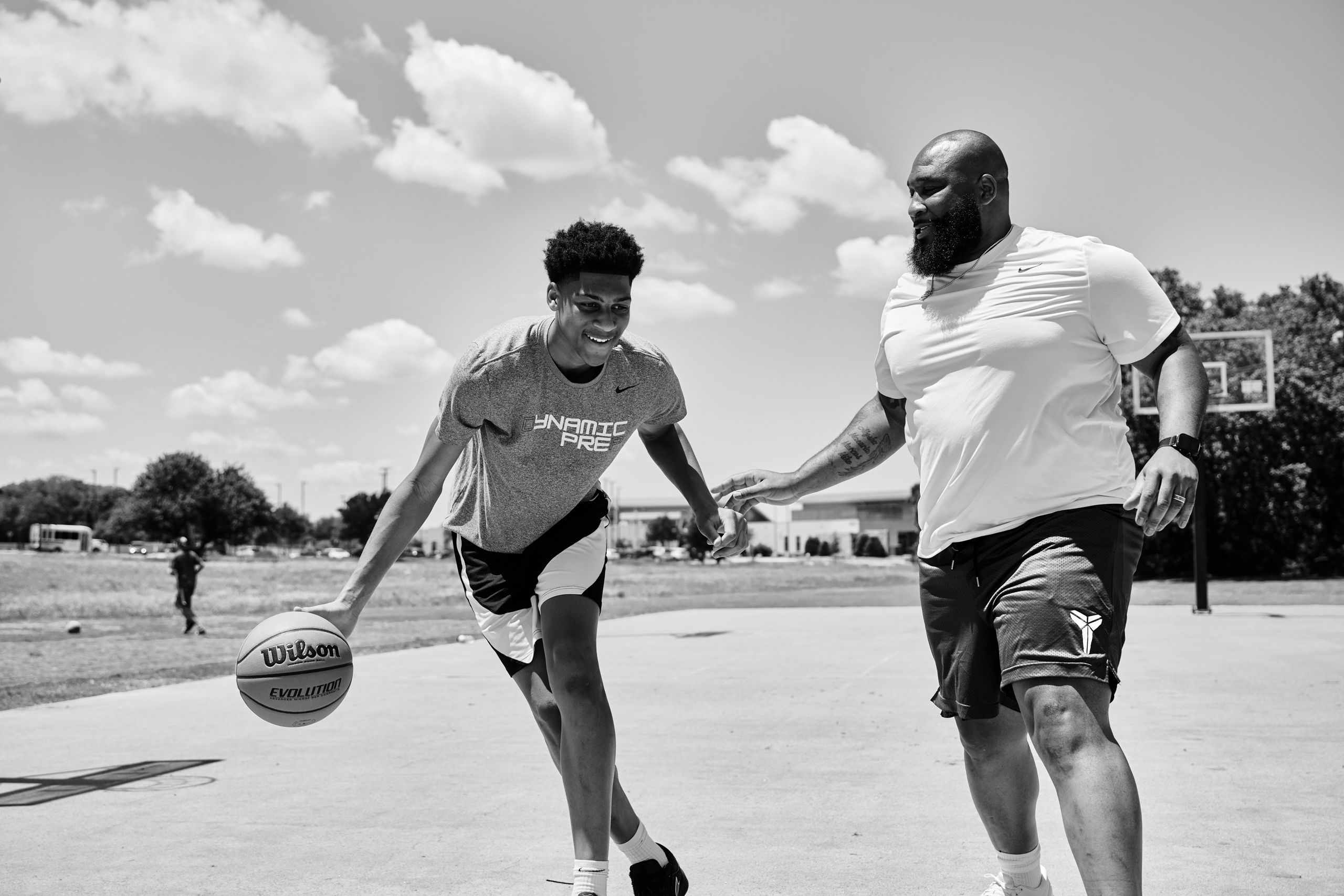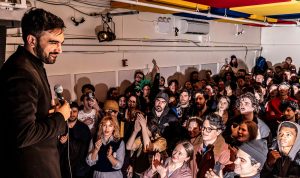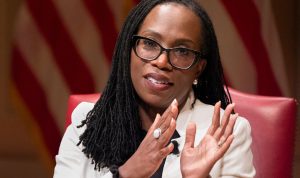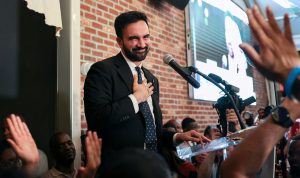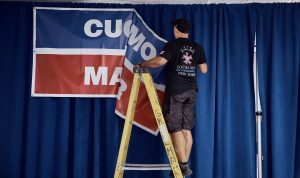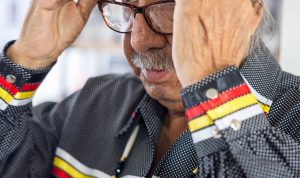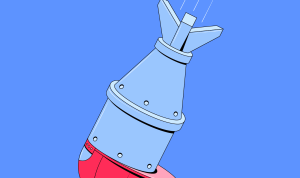American sports come with implied narratives. The story of baseball is fundamentally nostalgic, connecting us to childhood and to the country’s pastoral beginnings. Football tells a story of manly grit, with echoes of the battlefield. Basketball is the city game, as the sportswriter Pete Axthelm called it half a century ago, and its chief narrative, for decades, was about escaping the ghetto. Religious metaphors run hotter in basketball than in other sports: when Spike Lee set out to make an ode to New York City hoops, he named his protagonist Jesus Shuttlesworth, for the N.B.A. Hall of Famer Earl (Jesus) Monroe; LeBron James appeared on the cover ofSports Illustratedat the age of seventeen as “The Chosen One.” Every tall and prodigiously skilled teen-ager feels like an act of God. And no sport, perhaps other than soccer, with itspibesandcraques—the impoverished dribbling and juggling machines who hope to become the next Maradona or Pelé—so deeply mythologizes the search for talent. The savior of your N.B.A. franchise might be getting left off his high-school team in Wilmington, North Carolina, or he might be selling sunglasses on the streets of Athens, Greece, to help his Nigerian immigrant parents make ends meet, or he might be living with his mother in a one-bedroom apartment in Akron, Ohio. You just have to find him.
At least, that was the story. On a recent episode of “Mind the Game,” the podcast that LeBron James hosts with the coach and former point guard Steve Nash, James spoke with the young N.B.A. superstar Luka Dončić about how different James’s hoops upbringing had been from that of kids today. On the playgrounds of Akron, James said, he would play 21, in which the person with the ball tries to score against everyone else. Such games taught him how to improvise, how to get around multiple defenders and create scoring opportunities out of nothing. James is a father of two sons, who mostly learned how to play basketball “indoors,” in a “programmed” environment, he said. They were taught the game by a fleet of coaches and other professionals. “I didn’t have a basketball trainer until second, third, maybe fourth year in the N.B.A.,” James went on. “My basketball training was just being on the court.” Last year, Dončić founded a nonprofit that focusses on youth basketball; in December, the organization published a report arguing that, as youth sports have professionalized, they have become more exclusive, sucking the “joy” out of the game.
A video clip of the podcast was posted on TikTok, and the top comment beneath it reads, “Lebron will be one of the last superstars that’s from the ghetto, basketballs like golf now it’s a tutelage sport.” That might not be entirely true; if a seven-foot-two teen-age Kareem Abdul-Jabbar were walking around any neighborhood in New York today, he wouldn’t get far without a wannabe agent stopping him in the street. But, putting aside such once-in-a-generation talents, the landscape of the league has subtly changed. James and his older son, LeBron (Bronny) James, Jr., made N.B.A. history last year by suiting up as teammates, for the Los Angeles Lakers. And, while that was a first, being a second-generation N.B.A. player is becoming almost unremarkable. In 2009, ten players in the league had fathers who’d played for N.B.A. teams; this past season, there were thirty-five. The future promises even more hoop legacies. The likely No. 2 pick in the upcoming draft is Dylan Harper, whose father, Ron, played with Michael Jordan on the Chicago Bulls. Lists of top high-school recruits include the names Anthony, as in Carmelo, and Arenas, as in Gilbert. James’s younger son, Bryce, has committed to play for the University of Arizona and could also reach the N.B.A. soon.
Genetics is the most obvious explanation: if your dad is six feet eight and your mom is six feet two, you stand a better chance of guarding Kevin Durant—or Durant’s kids—than my children will ever have. But the N.B.A. has been around for almost eighty years, and the number of roster spots in the league has barely changed since the mid-nineties. If all that mattered were good genes, the influx of second-generation players would have shown up thirty years ago. Why the spike now?
To answer that question, one N.B.A. executive told me, you probably have to look at the economy of basketball development. The children of pros are generally wealthy and well connected; they have access to “better training, coaching, and the right people who can put them on the right lists,” the executive said. “Those early edges accumulate.” Increasingly, players are made as much as they are born, and making those players costs money. A star prospect requires a set of physical gifts that might as well be divine in origin. But, to compete now, he will also likely need the kinds of resources that you have to buy, and a small industry has arisen to sell them.
“It’s getting too expensive for some kids to even play, and the pressure to be perfect takes away the love for the game,” Dončić told me. “I think about my daughter and wonder what sports will feel like for her one day.” Jay Williams, a basketball analyst at ESPN who was the second pick in the 2002 N.B.A. draft, said to me, “When I came into the league in the early two-thousands, player development was mostly raw talent, repetition, and survival.” Now, he said, “development starts younger, it’s more specialized, and it’s driven by business.” Jermaine O’Neal, a six-time N.B.A. All-Star who recently founded a basketball-centered prep school, told me, “The cost of everything has changed.” O’Neal, like James, grew up with a single mother in a working-class area of a small city. Sports in general, O’Neal said, are “pricing out a percentage of athletes raised in communities like mine.”
The professionalization of youth sports has changed not only who reaches the N.B.A. but how the game is played when they get there. Watching the post-season this year, I found the level of play to be possibly higher than ever. But I felt little emotional connection to the game. Like many fans, I complain about the number of three-point shots that teams are taking, which turns so many games into an almost cynical exercise in playing the odds. Today’s style is also more rehearsed, more optimized. This, I believe, can be traced to the way that the players are learning the game from an early age—to the difference between a childhood spent outdoors with your friends, competing against grown men, and one spent as a customer, with a cadre of coaches who push you only in the ways that you or, in most cases, your parents approve of.
“What used to be driven by someone’s hunger to improve, to figure it out and work to get better, becomes a job for a lot of these kids so early,” Steve Nash told me. This, he added, meant “essentially trading their enjoyment and motivation for a calculated approach that may be more suitable to young adults than young kids.”
Does this shift also help explain why the N.B.A. has struggled to find its next superstars, successors to James, Steph Curry, and others of their generation? Perhaps. It’s true that a number of today’s best players—Dončić, Nikola Jokić, Giannis Antetokounmpo—are from other countries, and many Americans crave homegrown heroes. But the leading players in this year’s finals, Shai Gilgeous-Alexander, of the Oklahoma City Thunder, and Tyrese Haliburton, of the Indiana Pacers, are North American. (Gilgeous-Alexander is from Canada.) The former plays a throwback game that involves a lot of slithering through tight spaces; the latter makes surprising, lightning-quick passes and fires his jump shots with an awkward motion that resembles an old man pushing his grandchild on a swing. Yet neither player has caught the public imagination in the manner of a James or a Curry or a Durant. When fans argue about the next face of the league, they usually bring up Anthony Edwards, the charismatic guard on the Minnesota Timberwolves, or Ja Morant, of the Memphis Grizzlies, who floats through the air like his bones are hollow before exploding into some of the most violent dunks the league has ever seen. They are the basketball equivalents of James Brown: undeniably virtuosic, always on point, but with so much confidence and brio that they feel unpredictable and capable of anything. The new N.B.A. archetype, in contrast, feels more like an “American Idol” singing machine—technically flawless and with unlimited range, but ultimately forgettable for everyone except the vocal coaches on YouTube.
What happened? Once, a serious basketball prospect might simply play on his local high-school team and then head off to college. Nowadays, he will likely attend multiple schools, seeking exposure, playing time, and competition. The trend began slowly, in the nineteen-eighties, when secondary schools with big-time basketball programs—notably, Oak Hill Academy, in rural Virginia, the alma mater of Rod Strickland, Anthony, and Durant—began recruiting the country’s best players. Soon, explicitly sports-centered schools emerged. The talent agency IMG purchased the Nick Bollettieri Tennis Academy, in Florida, and expanded it to include other sports, adding basketball in 2001. Five years later, Cliff Findlay, a Las Vegas businessman who had made his money in car dealerships, opened Findlay Prep, which was, arguably, just a basketball team—a dozen or so boys from all over the world who played games around the country and took classes at a private school a few minutes away from the gym where they practiced. Findlay Prep won three national high-school titles in four years and produced eighteen N.B.A. players. It closed down, in 2019, when the nearby private school ended the partnership. Suddenly, Findlay’s students had nowhere to go to class.
This spring, I flew to Dallas to visit Dynamic Prep, the school that Jermaine O’Neal founded in 2022. It has eleven students, all of them Division I basketball prospects. Monday through Friday, the students gather at a twenty-four-thousand-square-foot training facility just north of the city. In the morning, they sit in a classroom and take an N.C.A.A.-approved curriculum of online courses. Then they head to the gym for strength training and conditioning, before basketball practice in the afternoon.
When I arrived, Dynamic’s student body was on the court. The team had recently been ranked tenth in the country by ESPN, helping it qualify as a late addition to the Chipotle Nationals, an annual tournament that unofficially crowns the country’s high-school champions. But Dynamic would face long odds against more established programs, including IMG Academy and Montverde Academy, another Florida school that consistently produces N.B.A. draft picks. And practice wasn’t going well. O’Neal, who is the head coach of the team in addition to being the school’s founder, stood on the sidelines, his arms crossed. He is nearly seven feet tall, with a high forehead and a dimpled chin; he still appears to be more or less in playing shape. The team had been running half-court sets for nearly thirty minutes, but nobody was where he was supposed to be—not even Jermaine O’Neal, Jr., the team’s small forward. O’Neal, Sr., had spent the first half of practice quietly simmering; then one player missed a defensive rotation and asked his flummoxed coach what was wrong. “Your demeanor!” O’Neal yelled, before ordering the player off the court. Another kid replaced him, and the ball was passed back to the top of the key. The drill began again.
O’Neal grew up in Columbia, South Carolina, and counts thirty-two siblings among his relatives. His mother taught him almost everything; he didn’t meet his father until he was thirty years old. At seventeen, just a few years after growing about nine inches in three months, he became one of the youngest players ever to reach the N.B.A. when he was drafted in the first round by the Portland Trail Blazers. He was part of a generation who skipped college entirely; the sports media was largely skeptical of kids who turned down college scholarships in favor of N.B.A. dollars, and these teen-agers often found themselves competing for playing time against men more than a decade older. O’Neal rode the bench for four years. But veterans on the team made sure that he understood his place on the roster and how to act like a professional. When he was traded to the Indiana Pacers, after his fourth season, he flourished.
O’Neal credits the playgrounds of his childhood with giving him instincts on the court and helping instill the resilience to endure what felt like an ignoble start to his career. He knows that the kids he coaches aren’t getting that kind of real-world instruction, and so he looks for ways to simulate it. “I’m taking a little bit of the hardship mind-set of how I grew up, and I’m bringing it to this new-school mind-set and mixing it,” he told me. The team’s intense practices and his focus on defense are partly meant to create an experience of adversity. He believes that his job is not only to prepare his players for what comes after Dynamic in college or in the pros but also to protect them from it. “Your coaches won’t love you—you’re just getting them closer to another win,” he yelled at one point during practice. “Once you get on campus, your parents will never be able to help you.”
In O’Neal’s view, a school like Dynamic is more sensitive to the needs of young athletes than traditional options are. Before founding the school, he created Drive Nation, a home for youth basketball and volleyball teams which was headquartered next to the car-rental center at Dallas Fort Worth International Airport. Drive Nation’s teams were affiliated with the Amateur Athletic Union, or A.A.U., an umbrella organization for club teams which, in the past twenty-five years, has become a major part of youth sports. At the time, O’Neal’s daughter, Asjia, was one of the top high-school volleyball players in the country. But, during her junior year, she told her parents that she was burned out: full-time school followed by practice and training—plus the travel and stress that came with playing for a club team and the United States youth program—had been too much. O’Neal began reading about other approaches to youth sports, and he talked to coaches in Europe. He learned about the Continent’s academy system, which plucks promising athletes at an early age and gives them a more specialized path, organizing their lives largely around their sport. Dynamic is his attempt to bring that system to the U.S.
Most of the kids at Dynamic won’t make the N.B.A., but all of them could play for major college programs—and big-time college basketball is a lucrative endeavor in itself. In 2021, the U.S. Supreme Court ruled that N.C.A.A. restrictions on the payment of student athletes were a violation of antitrust law; now student athletes can make money by selling their name, image, and likeness. Bronny James reportedly earned nearly six million dollars from such N.I.L. deals—with Nike, Beats by Dre, and other companies—before he left college. And you don’t have to be LeBron James’s son, or even a top N.B.A. prospect, to do well. R. J. Davis, a talented but undersized guard, spent five seasons at the University of North Carolina, becoming the second-highest scorer in the program’s history; he may not get an N.B.A. paycheck anytime soon, but he racked up at least twenty-five N.I.L. deals last year, which paid him more than two and a half million dollars. Players like him are staying in college longer than before, and many of them move around to pursue the best and most profitable opportunities by registering with the N.C.A.A.’s transfer portal, which notifies coaches at other colleges about the players who are newly available for recruiting. The day I visited Dynamic, the transfer portal had just opened up, and O’Neal informed his kids, early in practice, how many players had entered it. This, he was suggesting, is what they were up against: hundreds of young men vying for a limited number of spots that could be worth millions of dollars.
After practice, he gathered the team around him. “What do you all want?” he asked. The players hung their heads. “I’m going to be real with you,” he said. “Today was not good enough.” If the team hoped to succeed at the Chipotle Nationals, they would have to put in more effort. O’Neal pointed out that the number of players in the transfer portal had gone up since that morning. “Seven hundred in the portal now,” he said. “It’s a record. Every year, it’s a fucking record.” Then he repeated his question. “What is it you want?”
It’s an old complaint, but it’s still true: kids who have been given everything may end up lacking motivation. “I wish I’d had the access my kids have—the trainers, the recovery tools, the mental-health support,” Jay Williams told me. “It’s a smarter system now, but what I want to pass down to them is the hunger, the grit.” O’Neal made more than a hundred and sixty-seven million dollars in his playing career, and he has struggled to impart the lessons he learned in his childhood to Jermaine, Jr. “I had this thing where I’d say to him, ‘Man, you don’t understand how good you got it,’ ” he told me. “ ‘The only thing you’re missing is hardship. You fly on private jets. You drive a Range Rover. You’ve had a chef your entire life.’ I have literally missed meals. I’ve literally had one pair of shoes that were my school shoes, my basketball shoes, and, if I went to church, they were my church shoes.”
“I never wanted my kids to live like that, and I didn’t want to live like that,” he went on. “So I would ask Jermaine, Jr., ‘What are you starving for?’ And he couldn’t answer the question.” Eventually, Jermaine, Jr., came up with a response: he needed an emotional break from living in the shadow of both his dad and his coach. O’Neal has been trying to give him one.
Youth basketball is not an outlier in its trend toward professionalization. You can see the same story in countless aspects of American life. Fierce competition breeds cottage industries that promise advantages to the children of parents who can afford them. Those children crowd out their peers, and the path to upward mobility narrows. The kids playing sports at big-time college programs are examples of this trend, but so are many of the straight-A students who attend classes at those same colleges, whose parents may have paid for private tutors and consultants to help secure admission. Children from poorer families have to be extraordinary or they will fall behind.
The most highly touted prospect at Dynamic Prep, according to ESPN, is not Jermaine O’Neal, Jr.—the twenty-second-ranked small forward in the country—but another child of professional athletes. Marcus Spears, Jr., is the son of a retired N.F.L. defensive lineman and a former W.N.B.A. player, Aiysha Spears. June, as his parents call him, is six feet eight, with long arms and the lankiness of a teen-ager who is still growing. He can shoot from outside, defend at the rim, and trigger a fast break after a rebound. If he grows a few more inches, he’ll be the same height as Durant, one of his favorite players; his loping but graceful gait calls to mind a young Antetokounmpo. It may be ludicrous to invoke such superstars when discussing a kid who just turned sixteen, but scouting is an exercise in imagination, one in which the most salient inputs are limitations—if a prospect has T. rex arms or shoots like he’s angry at the ball, his spectrum of possibility shrinks. June was averaging fewer than seven points a game, but he has uncapped potential: you can map his body, skills, and movements onto many of the best players in the N.B.A. He’s currently the third-ranked high-school sophomore in the country, at any position in the game.
He’s also, for now, younger and skinnier than most of his teammates. At practice, I watched him get pushed around while his father paced the sidelines. Marcus Spears, Sr., was a football star at Louisiana State University before playing eight seasons for the Dallas Cowboys and another for the Baltimore Ravens. He’s now one of ESPN’s premier football analysts. On TV, he is self-deprecating and exceedingly likable, but on the sidelines he was like every other anxious basketball dad: muttering to himself when June didn’t rotate fast enough on defense, staring morosely at the floor when June took a spill onto the hardwood. When June declined to shoot an open jumper, he yelled, “Take the shot!”
Later that day, I visited Marcus and Aiysha Spears at their seven-thousand-square-foot house in a gated community near where the Cowboys practice. Aiysha grew up in Detroit—“the city,” she told me, “not the surrounding areas”—and was reared, in her early years, by a mother who wanted her to become a swimmer. Her mother died when Aiysha was thirteen, and she decided to take up basketball, mostly playing for her local school teams, with some A.A.U., too. “I was travelling by myself to tournaments,” she told me. “My mother passed away, my father wasn’t in my life, and my grandparents didn’t know what to do, so they trusted my coaches to handle it and make sure that I was O.K. I would be in Indiana or Chicago, and they definitely couldn’t pay to come watch me play in a tournament. The hundred and fifty dollars or whatever it would cost to see me, that was our electricity bill.”
Marcus, whose extensive array of barbecuing equipment sat on the back patio, grew up in a blue-collar family in Baton Rouge. His mother was a telephone operator for Bell South, and his father worked as an electrician before getting a job at the Georgia-Pacific paper mill. Spears echoed the other former pros I talked to when he described how he learned to play sports: “outside,” mostly in pickup games with older boys. Now he’s trying to teach toughness to his son. “I was super hard on June when he was young,” he told me. “I was looking at it from a prism of knowing what he was going to actually be. Like, ‘Your mom is six foot two, bro, and I’m a pro football player. She’s a pro basketball player. You’re going to be the one per cent of the one per cent of what you’re doing.’ ” He prodded his son to work harder, even cursing at him the way he knew June’s coaches someday would. “But I probably started a little too early with him, at seven or eight years old,” he said. “I still have to check myself at times now and realize he’s still fifteen years old, because when I was fifteen I wasn’t even close to what he is doing now.” Spears wants his son to succeed, and he knows that college sports have changed. “When I got to L.S.U., I was developing as a player,” he said. “Kids can’t sit on the bench and learn how to play anymore. They need to produce immediately or they’re gone.”
Kids who are serious about sports now don’t just spend hours practicing; they also spend hours building their brands. Today, just about every notable college prospect has dozens of tightly edited YouTube highlight reels and tens of thousands of Instagram followers. Top prospects used to meet one another at camps or at the annual McDonald’s All-American Game; they might have scanned one another’s names in the infrequent updates of high-school player rankings. Now those same players meet through social media and the booming youth-sports content business.
This is true across all kinds of activities. If you’re the best twelve-year-old chess player in a big city, you’ve probably competed in hundreds of online games against the other top twelve-year-olds across the world—you might even live-stream your matches and feed some of that content into the algorithms of TikTok and Instagram. Yogi Roth, an analyst at the Big Ten Network, has tracked the development of N.F.L. prospects for the past twenty-five years, and he believes that social media has fundamentally changed the experience of learning to play football. Roth played in college and coached for several years before going into television; in 2009, he became a producer and the host of “Elite 11,” which has been likened to “American Idol,” but for high-school quarterbacks. The show has featured sixteen future Heisman Trophy winners and was once a rare opportunity for players at that level to meet one another and compete. Now those connections are made online. “They find one another early,” Roth said. “And then they all get on the same club team, which draws even more connections.”
There are benefits to this hypervisibility—scholarship offers, attention from skilled trainers and coaches. But it also attracts predatory figures and creates additional pressure. Cautionary tales abound. The canonical basketball example is Julian Newman, whose highlight reels went viral when he was a fifth grader and not yet four and a half feet tall. He was written up in theTimesand featured on “Good Morning America”; an online marketing machine was built around him, much of it orchestrated by his father. But Newman was just five feet seven when he finished high school, and no big-time college program wants a tiny shoot-first point guard who might arrive with a long list of demands. He spent the next five years as a fading YouTube celebrity, challenging other content creators to one-on-one battles.
Marcus Spears, Jr., does not have a large social-media following, nor does he spend much time with influencers—relative to other top prospects, he has little online presence, which is mostly by design. “I’m not going to monetize my fifteen-year-old,” his father told me. “I’m not interested in him having three hundred thousand followers.” But he and Aiysha understand that this is a privilege: parents who need the sponsorship money will understandably want to turn the hype around their talented children into funds, and some may even view it as the best choice for their kids. Spears said that he and his wife can see the downsides of that attention because of their experiences as pro athletes. “Also, if I need to fly to L.A. because the best knee doctor is out there, I can do it,” he added. “But, if I wasn’t in this position, and monetization on Instagram was going to allow my kid to go to the best doctor, then I would do that for them.”
All the former pros I talked to were frustrated by the intensity of youth sports as it exists now, but they still participated in the system because, well, what good parents wouldn’t do the same to insure that their children kept up with other talented kids? If I had a child who could potentially play basketball in college or the pros, I would pay for all the trainers everyone else was paying for—and then, if I could, I would send them to play at Dynamic for Coach O’Neal. Most people probably would. As O’Neal put it to me, “Wherever there’s kids, there’s parents. Wherever parents and kids go, they’re going to spend money.”
Not everyone at Dynamic, or at the programs it competes against, has money. The established schools offer scholarships; Dynamic is in an “incubator” phase, O’Neal told me, and so, for now, is not charging tuition. But the student athletes at these schools have all learned to play ball through careful instruction. In early April, a couple of weeks before the N.B.A. playoffs, the Chipotle Nationals began. The kids in these games had a long way to go, but they already played a facsimile of the pro game. Big guys shot threes, guards drove the lane and kicked the ball out for more threes. Gone are the days of novel high-school offensive sets or, at least on this level, wild invention.
More than a decade ago, I travelled to Oak Hill Academy to watch some practices. Most of the kids I saw went on to play big-time college hoops; the school drew a level of talent similar to Dynamic’s today. But, watching Dynamic practice, I was struck immediately by how fast they moved; I felt almost as if I were watching a different stage of evolution. “The game has become faster, more positionless, and more physically demanding,” Bill Duffy, a former N.B.A. draft pick and one of the top agents in the league, told me. “Players are training at a high level from a much younger age, and that’s changed not only how they move but how they think about the game. The style of play has evolved to match the speed and specialization that comes with early development.”
All that training has also led to a uniformity of play. “I absolutely hate it,” Marcus Spears, Sr., told me. That sameness comes from learning the game in a controlled environment, he said. “I think that’s why so many players from overseas are the top names in the N.B.A. now, because not only do they learn the technical side—they play the game with the old-school principle of playing against people who are older than you.” At the turn of the century, there were thirty-six foreign-born players in the N.B.A. Last year, there were a hundred and twenty-five. The top European teens play in pro leagues, against veterans. “You develop instincts in those situations,” Spears went on. American kids, no longer learning on the playground, were losing theirs, he believed. “You hear N.B.A. players that have been in the league a while say these young players suck. It’s not that they suck—it’s just they can’t do anything if you don’t tell them to. You need to make reads in the game, you need to deviate away from the play because it didn’t work. Now everybody just looks around, like, ‘What do I do now?’ ” One coach told the authors of the report published by Luka Dončić’s foundation, “Players don’t know how to anticipate where the ball will fall because they’re so used to their trainers getting their rebounds.”
Steve Nash told me that his effort “to be creative and imaginative” as a player was driven in large part by what he didn’t know—and that, as much as he envied some of the tools that young prospects now have, constant training likely would have altered that. O’Neal, too, saw this as a problem with the way basketball is now taught. “They are literally training these kids like robots, and the players don’t have any feel anymore,” he said. “That’s why all the players look alike now. Hell, half these kids don’t even watch basketball—they watch YouTube.”
At the Chipotle Nationals, O’Neal’s focus on defense, at least, seemed to pay off. Dynamic’s first game was against the vaunted Montverde, and his squad jumped out to an early 12–2 lead, largely owing to the players’ defensive effort. June, who came off the bench, was conspicuously the tallest person on the floor and also conspicuously among the youngest. He finished the game with respectable numbers—five points, five rebounds, and a block in sixteen minutes—and Dynamic managed an upset. The next day, Dynamic blew out Link Academy, the second-ranked team in the country. (The most recognizable name on Link’s roster is Andre Iguodala, Jr., whose father is a four-time N.B.A. champion.) Dynamic won again in Round Three, reaching the finals against Christopher Columbus High School, a Catholic prep school in Miami. Columbus was led by Cameron and Cayden Boozer, the twin sons of the two-time N.B.A. All-Star Carlos Boozer. In the title game, Cayden scored twenty-seven points, Cameron chipped in eleven with eight rebounds, and Columbus got another twelve rebounds from Jaxon Richardson, whose father, Jason, played fourteen seasons in the N.B.A. Columbus won by eighteen points, ending Dynamic’s unlikely run.
There’s no inherent reason that silver-spoon players have to produce an inferior product on the court. And a certain kind of basketball purist—the sort who hates any talk of narrative and is interested only in what happens between the lines on the floor—would roll his eyes at questions about where the handful of players who make the N.B.A. come from.
Still, let’s indulge in one last metaphor. Basketball is like jazz in so many ways that the analogy has become a cliché. As Wynton Marsalis once wrote, “Both reward improvisation and split-second decision making against the pressure of time.” Both are also Black art forms that require incredible discipline and a lifetime of study but which, when performed at their highest levels, encourage a freedom of expression that can take the audience into an ecstatic state. Every hoops fan can think of at least one such moment. For me, it was watching LeBron try to single-handedly beat the Golden State Warriors in the 2015 N.B.A. Finals after his two most talented teammates went down with injuries. James broke from the established tempo of the game and birthed a moment of ugly genius, walking the ball up the court, ordering his overmatched teammates around like a conductor, and almost breaking the spirit of their opponents, one of the best teams of all time.
Maybe this is nostalgia on my part. Perhaps athletes trained in state-of-the-art gyms can bring as much drama and charisma to the court as those who learned to play by trying to score against older guys on a run-down playground. But I’m not sure that basketball can survive as a major sport if it loses all connection to the narrative that has woven it so deeply into American culture. Basketball’s past may not be as virtuosic or as technically sound as its future, but part of why we watch the game is to witness the come-up—the pain of losing followed by the moment when years of work produce an instant of ingenuity that finally gets the superstar to the top. And, because we are sentimental, we want to know that the journey started on the blacktops of Akron, or in some dusty church gym in Indiana, or on the playgrounds of Coney Island. Every great American story is sentimental in the same way: instincts born out of struggle, the triumph of the schoolyard over the classroom, uncommon creativity driven by necessity. ♦

